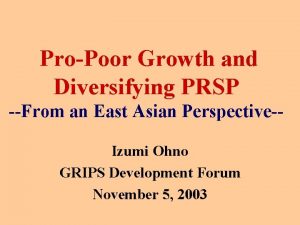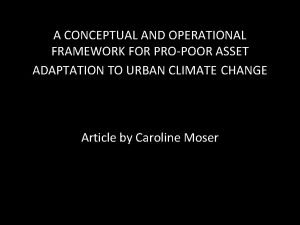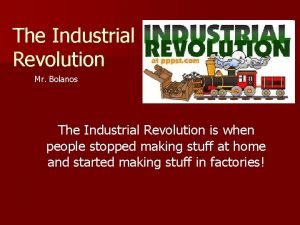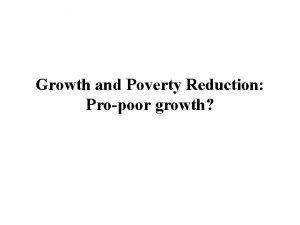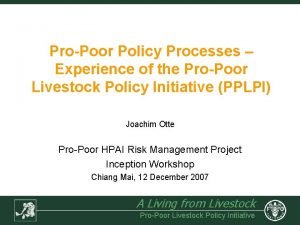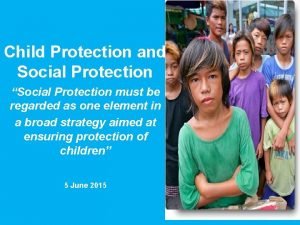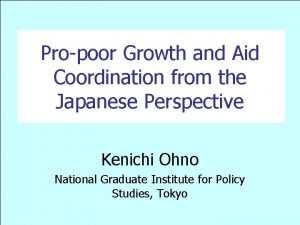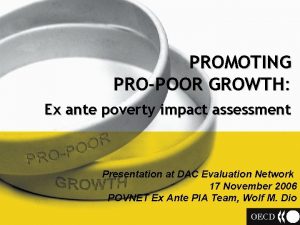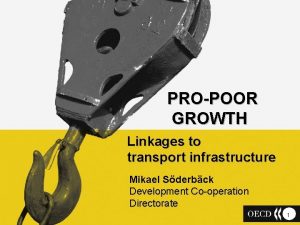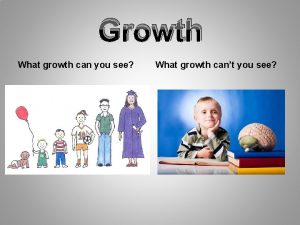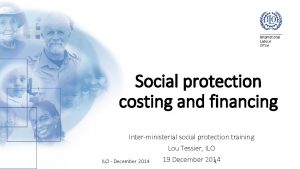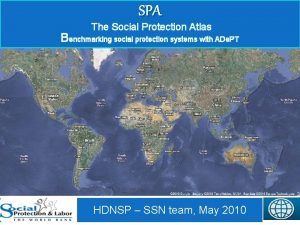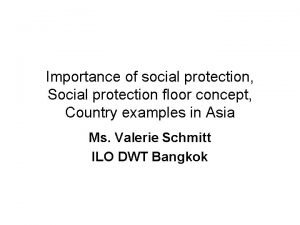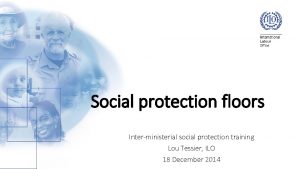How Can Social Protection Promote ProPoor Growth and


















- Slides: 18

How Can Social Protection Promote Pro-Poor Growth and Support MKUKUTA II GOALS Group II. Hon. Jenista Mhagama Anna Mwasha Daniel Masunzu Sospeter Nyanda Sarah L Mshiu Twaha Mwakioja Ida Manjolo Masuma Mamdani Janet S. Pima 1

Background: Concepts and Definitions • MKUKUTA II (National Strategy for Growth and Reduction of Poverty) is a framework that accelerates poverty reduction by pursuing pro poor growth interventions in Tanzania • Social protection includes concepts like poverty, vulnerability, generalized insecurity and disability. • Social protection promotes/enforces implementation of National Strategy for Growth and Reduction of Poverty Phase II (MKUKUTA II) in order to achieve its goals. 2

Social Protection in Tanzania • it is described as traditional family and community support structures, and interventions by state and non-state actors that support individuals, households and communities to: – Prevent, manage, overcome the risks threatening present and future security/well-being, and – Embrace opportunities for their development and for the social and economic progress 3

Social Protection is an essential investment that contributes to economic growth and makes growth more pro-poor while directly reducing poverty. It enhances the capacity of the poor and vulnerable groups to escape from poverty, better manage the risks they face and shocks. 4

The following are some of the pathways through which Social Protection promotes pro-poor growth and supports MKUKUTA II: (i). Human capital Investment • Social Protection directly improves the health status of people which in turn contributes to promoting economic growth • SP directly improves nutrition status and sanitation through cash transfers and awareness raising massages. (TZ has high stunting level in U 5) 5

• SP supports the participation of the poor in labor market through investment in education • SP increases access to public services particularly markets, health and education infrastructure, and helps to raise productivity, 6

• Social Protection is crosscutting and supports all clusters in particular cluster II (Improvement of Quality of Life and Social Well-Being) of the MKUKUTA II to achieve its goals of -: - Ensuring equitable access to quality education at all levels for males and females, universal literacy for adults, both men and women. - Improving survival, health nutrition and well being, especially for children, women and vulnerable groups. - Increasing access to affordable clean and safe water, sanitation and hygiene. 7

II. Social Protection and Security : Problem statement i Other poor Households (6. 8 million people) Food insecurity/ chronically poor Households (6. 4 million people) A IG or b a L n i e iv s en t In G V , d an tra g n ni Improvement of Social and Economic Services Basic needs poverty line (33%) food poverty line (16%) h r as o l a al C ks r n o io ion t W i d dit c i n l b Co con fers Pu un ans Tr 8

Cluster II: Improvement of Quality of Life and Social Well-Being • focusing on quality of life of the poorest and most vulnerable groups, reduced inequalities in access to social services such as education, survival, health across geographic, income, age, gender and other groups, and provision and access to clean and safe water, sanitation, decent shelter and energy, safe and sustainable environment, access to social security and social protection, and thereby reduced vulnerability from environmental risk. 9

Food Security v. The more insecure you are the more you are likely to engage in negative coping mechanism like taking children out of schools, selling assets, migrating etc going deeper into poverty. v social protection interventions will make people more secure and begin to protect their assets and start looking for opportunity to invest in production, begin savings and service sectors. v. This stabilizes the demand for agricultural output, particularly in remote rural communities, and this stimulates agricultural development. 10

Insurance • Health insurance –( illness is counter productive) • Social security (pension) • Warehouse Receipt Services (linkages to SACCOs) • Crop Insurance 11

Crop Insurance v Provides security to farmers such that when shocks such as droughts, rains occurs farmers can bounce back through payment by insurances v. Warehousing Receipt System (WRS) has played a catalytic role not only in terms of improved marketing of agricultural products, but also improved agricultural production and productivity, farmer’s confidence, stability of producer’s prices. v. Improved Forward and backward linkages security in the agricultural sector enhance economic growth 12

cumulative proportion of income South Africa’s social grants reduce inequality substantially 100% 75% 50% Lorenz curve with transfers 25% Lorenz curve without transfers 0 0 SOURCE: EPRI 25% 50% 75% cumulative proportion of sample 100% 13

III. Economic Resilience Social Protection provides efficient economic stimulants and: • Enables economy to better withstand internal and external shocks • Provides an automatic stabilizer for the economy 14

Economic Resilience • All the earlier SP interventions at the micro level will contribute to the economy being able to withstand internal and external shocks 15

Economic Resilience • Other potential SP interventions: – Agriculture input vouchers for fertilizers and improved seeds to small scale farmers/ producers. – Promote social health insurance to ensure access to quality health care to increase economic resilience (through farmer’s associations) – Promote alternative livelihood schemes (drought resistant), diversification from farming 16

IV. Economic Reforms: MKUKUTA II Cluster I • SP shares the benefits of economic growth • Makes any economic reform program more pro-poor • SP increases the likelihood of success of the reforms 17

Economic Reforms (more examples) – Ensure that reforms protect farmers and the poorest from increasing fuel and kerosene costs: price controls, for e. g. include a package to stabilize the price of kerosene – Should be long lasting, include export and import measures to protect farmers, for example: • Lift import restrictions and give tax exemptions to allow imports during shortages (e. g. sugar imports) • Restrict exports in times of food shortage 18
 Propoor
Propoor Propoor
Propoor What is fccla's mission
What is fccla's mission Promote personal growth
Promote personal growth Plant growth analysis
Plant growth analysis Root hair structure
Root hair structure Primary growth and secondary growth in plants
Primary growth and secondary growth in plants Vascular ray
Vascular ray Implement tasks that promote reasoning and problem solving
Implement tasks that promote reasoning and problem solving Langars and midday meals promote community eating
Langars and midday meals promote community eating Protect, promote, and improve the health of all people
Protect, promote, and improve the health of all people Step growth polymerization vs chain growth
Step growth polymerization vs chain growth Geometric growth population
Geometric growth population Neoclassical growth theory vs. endogenous growth theory
Neoclassical growth theory vs. endogenous growth theory Difference between organic and inorganic growth
Difference between organic and inorganic growth Handling information in health and social care
Handling information in health and social care Apa itu social thinking
Apa itu social thinking Social thinking social influence social relations
Social thinking social influence social relations Mr bolanos
Mr bolanos
